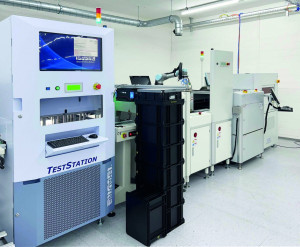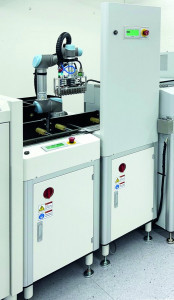High line speed, no webs and closely positioned modules: For this requirement, the Swiss EMS manufacturer Canastra AG relies on a combination of laser depaneling and an integrated test system. The stand-alone solution was highly automated using a cobot.
 The panel is tested fully automatically by ICT and then separated inline with a CuttingMaster Two product examples demonstrate Canastra AG's innovative potential and product range - partly under its own name and partly as a partner in the background: Example 1 is the Shark Eye, which was developed for the management of waste containers. It is equipped with an intelligent measuring system and radio communication and prevents unnecessary trips to waste garbage cans that are not sufficiently full. Example two is the first induction-based sous vide cooking appliance. This world first was developed together with Erme AG. The professional appliance is directly connected to the cookbook and can be fully operated via an app, which even impresses top chefs.
The panel is tested fully automatically by ICT and then separated inline with a CuttingMaster Two product examples demonstrate Canastra AG's innovative potential and product range - partly under its own name and partly as a partner in the background: Example 1 is the Shark Eye, which was developed for the management of waste containers. It is equipped with an intelligent measuring system and radio communication and prevents unnecessary trips to waste garbage cans that are not sufficiently full. Example two is the first induction-based sous vide cooking appliance. This world first was developed together with Erme AG. The professional appliance is directly connected to the cookbook and can be fully operated via an app, which even impresses top chefs.
In addition to these two examples, the engineering and production service provider Canastra produces many different assemblies for a wide range of applications and is therefore very flexible. In 2021, however, one customer had a special requirement that could not be met straight away: a particularly high line cycle was absolutely essential for the large order. "It had to be possible to adhere to a fixed cycle time and the distances between the individual modules on the panel were relatively narrow," says Christian Bräm. The Canastra CEO therefore set out to find a suitable separation and test system solution for his machinery.
Fixed cycle time had to be adhered to
 The cobot system for automating the laser depaneling machine was developed by LPKF and SmartRepThelarge-scale project was under great time pressure right from the start. Production had to start quickly. Bräm therefore contacted Andreas Keller from SmartRep and together they analyzed the exact requirements: "A fully automated cutting island with an integrated test system was to be created," recalls SmartRep CEO Keller. Together with his experienced partners LPKF and Teradyne, he was then able to develop a specially tailored concept with a cobot system. Bräm on the preliminary considerations: "We looked at and evaluated all separation processes." These included various milling systems. "Laser depaneling convinced us above all in terms of tool wear, flexibility and accuracy." This quickly tipped the scales against the milling cutter.
The cobot system for automating the laser depaneling machine was developed by LPKF and SmartRepThelarge-scale project was under great time pressure right from the start. Production had to start quickly. Bräm therefore contacted Andreas Keller from SmartRep and together they analyzed the exact requirements: "A fully automated cutting island with an integrated test system was to be created," recalls SmartRep CEO Keller. Together with his experienced partners LPKF and Teradyne, he was then able to develop a specially tailored concept with a cobot system. Bräm on the preliminary considerations: "We looked at and evaluated all separation processes." These included various milling systems. "Laser depaneling convinced us above all in terms of tool wear, flexibility and accuracy." This quickly tipped the scales against the milling cutter.
Canastra produces around 8,000 modules without separators per day for this customer order. After the ICT, the parts are separated from the FR4 material with a full cut. The cycle time is just under 4 seconds per piece. "As personnel costs are very expensive in Switzerland, we have to keep the level of automation correspondingly high," says Bräm about the necessary high level of automation.
"Although the availability of parts caused additional difficulties during this time, the project went off without a hitch; commissioning and the start of production were completed within a week," says Bräm.
Assembly of the fully autonomous Highrunner laser separation island with cobot and integrated test system: the panel is tested fully automatically by ICT and then separated and packaged inline. The integrated ICT solution from Teradyne checks all assemblies fully automatically and inline. The cobot then places the multiple panel on a frame. LPKF's CuttingMaster then lasers the modules out of the PCB in 4 seconds per single panel, and the cobot removes the laser-cut parts for automatic packaging. The systems are connected by handling solutions from YJ Link by SmartRep.
Although Canastra has designed the entire island for one product, as the distances available for separation on the panel are generally becoming smaller and smaller, the system will certainly be flexible enough to be used for other jobs in the future. The possibilities of laser cutting are much better than those of classic milling when it comes to the smallest webs: "Basically, the CuttingMaster makes sense wherever module distances are very small and high precision is required. We were also impressed by the lower maintenance costs," says Bräm. He believes that this investment has put his machine park in a good position for the future, regardless of large-scale production.
www.canastra.ch, www.lpkf.com, www.smartrep.de, www.teradyne.com


